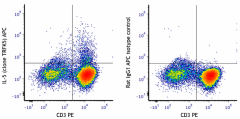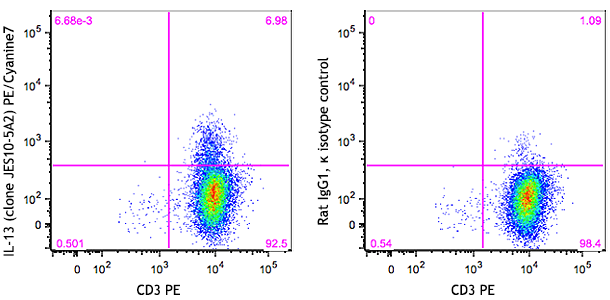- Clone
- TRFK5 (See other available formats)
- Regulatory Status
- RUO
- Other Names
- Interleukin-5, Eosinophil differentiation factor (EDF), Eosinophil colony stimulating factor (Eo-CSF), B cell growth factor-2 (BCGF-2), B cell differentiation factor for IgM (BCDF-m), IgA enhancing factor (IgA-EF), T-cell replacing factor-1 (TRF-1)
- Isotype
- Rat IgG1, κ
- Ave. Rating
- Submit a Review
- Product Citations
- publications

-

Th2 polarized BALB/c splenocytes were stimulated with PMA + ionomycin for 6 hours and then were stained with anti-mouse CD3 PE, and intracellularly stained with anti-mouse IL-5 (clone TRFK5) APC (left) or rat IgG1 APC isotype control (right).
| Cat # | Size | Price | Quantity Check Availability | Save | ||
|---|---|---|---|---|---|---|
| 504305 | 25 µg | 82€ | ||||
| 504306 | 100 µg | 263€ | ||||
IL-5 is a homodimeric, disulphide-linked protein produced by T-cells. Monomeric human IL-5 is a 126 amino acid protein with a reported molecular weight of 26 kD for the homodimeric protein. Mouse and human IL-5 are approximately 70% identical. IL-5 has been shown to promote the growth of immature hematopoietic BFU-E progenitors, stimulate the activation and differentiation of eosinophils, and promote the generation of cytotoxic lymphocytes. Mouse IL-5 induces the differentiation and proliferation of pre-activated B-cells and stimulates the production and secretion of IgM and IgA by B-cells stimulated with bacterial endotoxin. The TRFK5 antibody can neutralize the bioactivity of natural or recombinant IL-5.
Product DetailsProduct Details
- Reactivity
- Mouse,Human
- Antibody Type
- Monoclonal
- Host Species
- Rat
- Immunogen
- Partially-purified T cell clone supernatant
- Formulation
- Phosphate-buffered solution, pH 7.2, containing 0.09% sodium azide.
- Preparation
- The antibody was purified by affinity chromatography, and conjugated with APC under optimal conditions.
- Concentration
- 0.2 mg/ml
- Storage & Handling
- The antibody solution should be stored undiluted between 2°C and 8°C, and protected from prolonged exposure to light. Do not freeze.
- Application
-
ICFC - Quality tested
- Recommended Usage
-
Each lot of this antibody is quality control tested by intracellular immunofluorescent staining with flow cytometric analysis. For flow cytometric staining, the suggested use of this reagent is ≤1.0 µg per million cells in 100 µl volume. It is recommended that the reagent be titrated for optimal performance for each application.
- Excitation Laser
-
Red Laser (633 nm)
- Application Notes
-
ELISA1,3,4 or ELISPOT2,6 Capture: The purified TRFK5 antibody is useful as a capture antibody for a sandwich ELISA or ELISPOT assay, when used in conjunction with biotinylated TRFK4 antibody (Cat. No. 504402) as the detection antibody for mouse IL-5, or used in conjunction with biotinylated JES1-5A10 antibody (Cat. No. 501002) as the detection antibody for human IL-5. The Ultra-LEAF™ purified antibody is suggested for ELISPOT capture.
Flow Cytometry: The fluorochrome-labeled TRFK51 antibody is useful for intracellular immunofluorescent staining and flow cytometric analysis to identify IL-5-producing cells within mixed cell populations.
Neutralization1,9: The Ultra-LEAF™ purified antibody (Endotoxin <0.1 EU/µg, Azide-Free, 0.2 µm filtered) is recommended for neutralization of human IL-5 bioactivity (Cat. Nos. 504313-504318).
Additional reported applications (for the relevant formats) include: Western blotting, immunohistochemical staining of formalin-fixed paraffin-embedded tissue sections8 and paraformaldehyde-fixed, saponin-treated frozen tissue sections7, and immunocytochemistry.
Note: For testing human IL-5 in serum or plasma, BioLegend's ELISA Max™ Sets (Cat. No. 430401 and 430404) are specially developed and recommended. For testing mouse IL-5 in serum, plasma or supernatant, BioLegend's ELISA MAX™ Sets (Cat. Nos. 431201 and 431206) are specially developed and recommended. -
Application References
(PubMed link indicates BioLegend citation) -
- Abrams, J. 1995. Curr. Prot. Immunol. John Wiley and Sons, New York. Unit 6.20.
- Klinman, D., et al. 1994. Curr. Prot. Immunol. John Wiley and Sons, New York. Unit 6.19.
- Swain, S., et al. 1990. J. Immunol. 145:3796.
- Abrams, J., et al. 1992. Immunol. Rev. 127:5.
- Assenmacher, M., et al. 1994. Eur. J. Immunol. 24:1097.
- Karulin, A., et al. 2000. J. Immunol. 164:1862.
- Andersson, U., et al. 1999. Detection and quantification of gene expression. New York:Springer-Verlag.
- Fan, W. Y., et al. 2001. Exp. Biol. Med. 226:1045.
- Sitkauskiene, B., et al. 2005. Respir Res. 6:33.
- Product Citations
- RRID
-
AB_315329 (BioLegend Cat. No. 504305)
AB_315330 (BioLegend Cat. No. 504306)
Antigen Details
- Structure
- Cytokine; dimer; 40-50 kD (Mammalian)
- Bioactivity
- Growth/differentiation of B cells, eosinophils; proliferation/cell activation/differentiation of eosinophilic granulocytes
- Cell Sources
- Mast cells, T cells, eosinophils
- Cell Targets
- Eosinophils, B cells
- Receptors
- Heterodimer IL-5Rα (CD125); β-subunit (CDw131) in common with IL-3R, GM-CSFR
- Biology Area
- Immunology
- Molecular Family
- Cytokines/Chemokines
- Antigen References
-
1. Fitzgerald, K., et al. Eds. 2001. The Cytokine FactsBook. Academic Press, San Diego.
2. Takatsu, K., et al. 1988. Immunol. Rev. 102:107.
3. Takatsu, K. 1992. Curr. Opin. Immunol. 4:299.
4. Takatsu, K. 1991. Microbiol. Immunol. 35:593. - Gene ID
- 16191 View all products for this Gene ID 3567 View all products for this Gene ID
- UniProt
- View information about IL-5 on UniProt.org
Customers Also Purchased
Compare Data Across All Formats
This data display is provided for general comparisons between formats.
Your actual data may vary due to variations in samples, target cells, instruments and their settings, staining conditions, and other factors.
If you need assistance with selecting the best format contact our expert technical support team.
 Login / Register
Login / Register 


















Follow Us